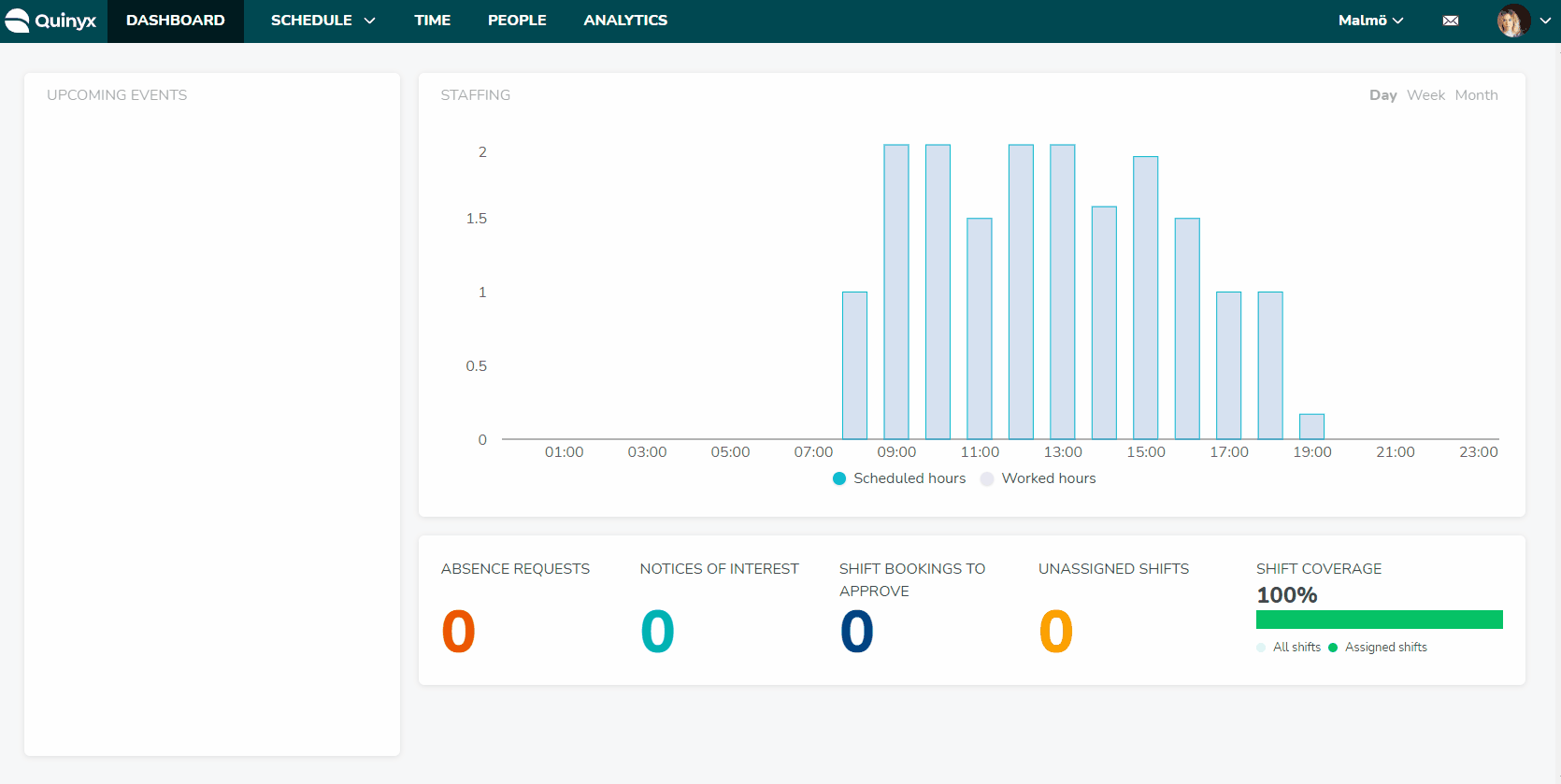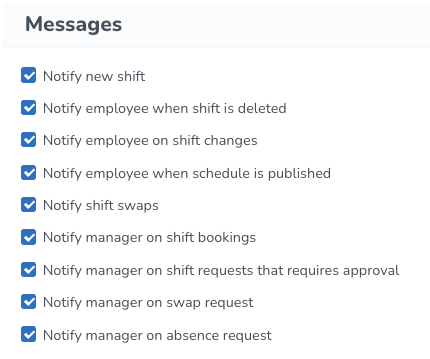Group management - Advanced unit settings
Working with advanced settings
If you want to edit additional settings for the unit, click on Advanced unit settings at the bottom of the side panel. A full-page form with all the settings available for the unit will open.

General settings
Give the unit a name, the first unit should be a main unit. The settings in the main unit will then be the same for other subsequent units created.

For restaurants in Sweden, the company number (org. nr) must be added for the Presence report to be valid. Read more about generating reports here.
Information
If the unit is not a main unit, enter company information including the company registration number. This is important in order to produce reports (for example, as personnel registers for the restaurant industry).

This information must be added if you want to use the e-signing PDF functionality Scrive since some of the information for the PDF is mapped from the unit card.
Miscellaneous

- Select cost center: Select a default cost center.
- Override cost center in Webpunch: Tick this to override the cost center when punching in Webpunch.
- Next badge number: Select the badge number you want to start with when creating a new employee
- Number of unsocial time periods: Select how many unsocial hours periods will be used. It's possible to select up to 8 unsocial hours periods.
- Daybreak: Select the hour from which the display is to begin in the schedule view.
- Breaks/Shifts: Select the maximum number of breaks per shift. Max 4.
- Autopublish schedule: Select whether the schedule will be published automatically and at which frequency; options are Disabled, Days, Weeks, or Months.
- Schedule approval: Select whether you want one-step approval, two-step approval, or no approval necessary.
- First level approver role: You can select whether you want the account owner/manager, section manager, manager, local manager, or district manager to be the first level of approval.
Settings
Under Settings, you can select the first day of the week, time zone, currency, minutes to auto log out, and allow SSO login.

- First day of the week: Which day should be displayed as the first day when looking at the weekly view in the Schedule?
- Time zone: This has the same functionality as on the first page of the unit card.
- Language: Which language you choose can affect some settings.
- Currency: For salary and cost calculations. Which currency do you want Quinyx to display?
- Minutes to auto log out: This has the same functionality as on the first page of the unit card. You can select no auto logout or logout up to 60 minutes in five-minute increments (5, 10, 15...). The default is currently 15 minutes. When set to default the unit inherits the setting from the Main unit.
- Allow only SSO login: If logging in to Quinyx should only be available on SSO. SSO then needs to be configured in Quinyx for your account.
Messages
Configure under which circumstances you want employees to receive messages.

If Notify new shift, Notify employee when shift is deleted, and Notify shift changes are enabled, and the employee has the agreement setting Allow punching on tasks, then the employee will be notified when a task is changed on their shift in a published period.
The employee will receive a notification in the following cases (only valid in published periods):
- When a task is assigned to an employee.
- When the time or date has changed.
- When a task has been deleted.
Note that when a manager creates, updates or deletes an absence for a given employee, as well as when they approve or deny said employee’s absence requests, Quinyx will always notify the employee.
Functionality
You can configure group management functionality settings under Functionality.

- Auto approve shift bookings: Tick this if you want to permit shift bookings for staff, provided that all requirements for booking the shift are met.
- Auto approve shift swap: Tick this if you want to allow staff to change shifts when all requirements are met.
- Shift assignment on away unit requires approval: Tick this if you want to require that a shift assignment on an away unit must be approved.
- Anonymous shifts: Select whether the shifts displayed under My schedule are to be anonymous, or whether the names of staff are displayed.
- Allow overlapping leaves: Select whether it's possible to have overlapping leave.
- Select manager on absence request: Select whether the employee's manager is selected automatically or whether the employee is allowed to select a manager from a list. In the latter case, the employee will select any manager with a manager portal role in the employee’s home unit tree.
- Delete Notice of Interest when booking a shift: Select whether expressions of interest are to be deleted when booking shifts.
- Pin code in mobile app: Require the user to enter a PIN code every time they open it.. The user will be asked to create a PIN code when logging in for the first time.
- Only allow punch out within coordinates: Only permit punching out if the employee is within the coordinate radius defined for the unit. If they leave the coordinate radius without clocking off, they will be clocked off automatically in accordance with the auto clock-out settings for the agreement or agreement template.
Rules for hours
You can set up rules for working time that apply to employees. The rules you set are useful in the schedule. Quinyx generates warnings when the rules are breached. If rules are set on the employee's agreement, those will override the rules set on the unit.
The rules for hours are also configured in the agreement templates. The rules in the templates will override the rules on the unit for the employee associated with the template.
Example:
- Create an unassigned shift = unit setting rules.
- Create a shift for an employee with agreement template = templates settings.
Rules for working time
Set specific working time hours.

- Max hours/day: The maximum number of hours the employee may be scheduled per day before Quinyx issues a warning.
- Per week: In this case, Quinyx has specified that the scheduled time per week may amount to a maximum of 48 hours.
- Minimum rest/day: The minimum rest period, daily rest, is set to 11 hours in the example. The box on the right determines whether the rest period can extend beyond daily break (in which case the box is checked) or whether the total rest period must fall within the preset 24-hour period (the box will be unchecked). In the latter case (with the box unchecked), there is no need for 11 hours' rest between work shifts, but the rest period can be taken any time during the 24-hour period, but not extending beyond daily break.
- Rest must be in connection with the daybreak: If unchecked, minimum rest/day needs to occur anytime between daybreak.
- Minimum hours/week: The minimum limit for scheduled hours per week.
- Free days: The minimum number of consecutive days off the employee is entitled to after working the maximum period specified in the field above.
- Max days: The maximum number of consecutive days that may be scheduled for the same employee. Quinyx generates a warning if the employee is scheduled for more than these consecutive days.
- Minimum rest/week: Just as with daily rest, you can specify how many hours of continuous weekly rest the employee is to have. E.g., 35 hours. Quinyx will also generate a warning in this case if the minimum weekly rest quota is not met.
- Check minimum rest/week during any consecutive 7 day period: Check minimum rest/week during any consecutive 7 day period
- Schedule bank holidays: If the agreement template covers people who work in a unit that, for instance, closes for every bank holiday, such as a head office, this box can be unchecked. You will then receive a warning about trying to schedule employees for days entered as bank holidays in Quinyx.

- Daybreak daily rest: This refers to the time for daily daybreak. This value set here will impact min daily rest, min weekly rest, max hours per day, and max hours per week.
- Minimum free weekends/year: This field can be used if the employee is entitled to have a certain number of weekends off per year.
- First day of the week: Specify the first day in a 7-day period. This period is specified so that Quinyx can monitor within which 7-day period the weekly rest quota is achieved.
- Unsocial time threshold: Some collective agreements state employees must work a certain number of hours per week or calculation period for employees to be entitled to unsocial time compensation. This compensation will in that case be based on the relevant unsocial time periods. Unsocial time compensation will be generated only when the specified time limit is reached. When the time limit is reached, said compensation will also apply retrospectively to the whole period.
- During days/Maximum days/With over hours: These three fields are used in conjunction with each other and are only relevant for a few collective agreements. In these collective agreements, there's a rule that during a particular period, there's a limit to the number of days during which the employee may work shifts exceeding the number of hours. As an example, the rule could say that during a time period of 10 days, a maximum of 3 days worked by the employee may contain shifts with over 10 hours. A warning is generated in Quinyx if the rule specified in these three fields is broken.
- Minimum shift length: Click Add to add any rules on the minimum shift length for which an employee can be scheduled. For example, the shift must be at least 6 hours if the shift starts anytime between 19:00 and 03:00.
Rules for breaks
Configure rules for breaks here.

- Calculate breaks as working time: Use this if you apply meal breaks (paid lunch breaks) in the workplace. This box must be ticked. Read more about meal breaks here.
- Maximum work hours w/o breaks (h): You can indicate the maximum number of work hours allowed without breaks.
- Minimum break (minutes)/ Maximum break (minutes): You can indicate the length of the shortest and longest break. A warning is generated if you staff a shift with a break time shorter or longer than the minimum or maximum.
Schedule changes
- Lock for schedule changes: Set the duration of the schedule lock in months, weeks, or days. This will trigger a warning if you try to schedule an employee within this period.
SMS/Coordinates
Configure SMS and coordinates in this section.

- Country code: Enter the country code for the location.
- Application ID: Application ID.
- SMS provider: Select the SMS provider.
- Get default SMS settings: Click this to have the following fields automatically populated.
- Service ID: Service ID.
- User name: Enter a company-specific user name.
- Password: Enter a unique password.
- Two-way SMS number: Enter a two-way SMS number.
- SMS Sender: Enter the SMS sender.
- Coordinates: You can manually configure latitude, longitude, and radius here. These are defined in meters, and 1 meter = 3.2808399 feet. If the coordinate is around a specific location it could be good to add the location name and address so you know what has been set up.
Shift
You can configure shift types.

- Default shift type: Select the default shift type that should be created if an employee punches in without being scheduled.
- X day shift type: First day off.
- V day shift type: Second day off.

